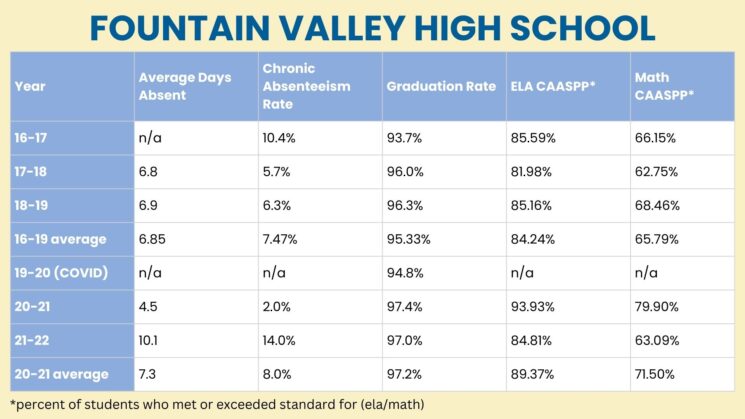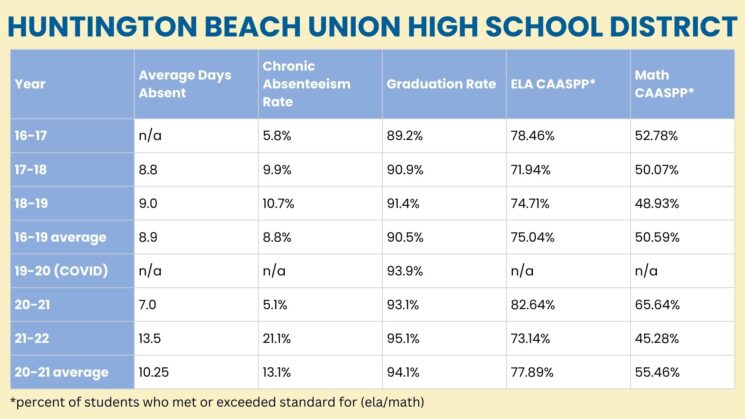By Katelynn Luu
The COVID-19 pandemic brought many changes to educational settings with the rise of online school and distance learning. When the federal COVID-19 Public Health Emergency declaration ended in May 2023, schools returned to their pre-pandemic states. However, despite the end of the pandemic, the effects of the pandemic still remain in some aspects of schools and the classroom.
Baron Banner gathered various avenues of data from both a school-wide and district-wide scale sourced from Data Quest and EdData. The average days absent, chronic absenteeism rate, graduation rate and percent of students who met or exceeded the standard of the ELA and math California Assessment of Student Performance and Progress (CAASPP) from before and after the COVID-19 pandemic were examined.


The little difference in the average of these avenues of data before and after the 2019-2020 school year can be attributed to the normal fluctuations seen each year. The lack of a significant difference indicates that both Fountain Valley High School (FVHS) and Huntington Beach Union High School District as a whole have made a successful comeback in restoring pre-pandemic performance in regards to these avenues of data.
Changing the scope of the investigation to a classroom setting revealed more ways that the pandemic impacted learning at schools. Baron Banner surveyed teachers to ask them what changes they have made or noticed in their classrooms since the pandemic.
Teachers’ answers covered a variety of topics including the increased use of digital learning tools and changes in grading policies.
“I used to check hard copies of homework, but post COVID I continue to have students submit homework digitally. This allows me more time to view homework to grade and have a record I can look back on if needed,” math teacher Jamie Tungyoo said. “I also keep all my video lessons available for students to view if they are absent, need to review the content, or maybe even work ahead. It seems to be a valuable resource for students.”
Biology teacher Terah French had a similar response.
“I use digital notebooks instead of paper ones, and students seem to do better as they are not trying to keep track of so many papers. I also post more items online in Canvas in a digital format to save paper,” French said. “It is also easier now with those changes for students to catch up after absences or keep up while they are absent. I think that it puts time management skills in the hands of students more and allows them to plan for their own schedules outside of the classroom.”
However, not all teachers have continued to digitize their classrooms. Social science teacher Michael Kral returned to traditional paper and pencil assignments and placed students in physical groups.
“Some kids enjoy staying on their computers, but compared to my other colleagues’ classes, I see more talking and interactions with peers,” Kral said.
Like Kral, some teachers noted the difference in student behavior compared to before the pandemic.
“Behavior has changed dramatically. Classes are ridiculously quiet and reticent to participate and this is sad as human beings are meant to interact in person face-to-face, not just in a digital format or texting,” French said. “It is a hard trend for all, not just students; it is a societal issue.”
Not only has student behavior changed, but also student performance in classes.
“Students overall seem less able to deal with strict deadlines, written directions, long exams and highly mentally demanding work,” chemistry teacher Lisa Battig said. “I would also say that many students seem less willing to speak with me in person and would rather email or message. Although, I’ve seen that trend begin to change back — which I’m quite grateful for.”
Despite all the changes that teachers have witnessed, they may not be permanent. Some teachers have taken measures to push students towards pre-pandemic standards of behavior and academic performance.
Chemistry teacher Michael Olsberg became more lenient in his grading policy towards student work during the pandemic.
“I have incrementally decreased my leniency as the years since the pandemic have increased,” Olsberg said. “Students have responded positively to higher expectations.”
Although the impact of the COVID-19 pandemic has not disappeared from classrooms, teachers at FVHS have been working towards bouncing back.





